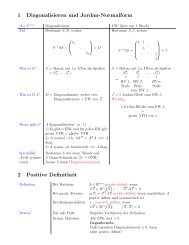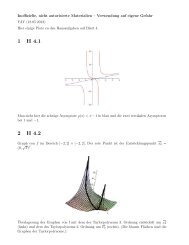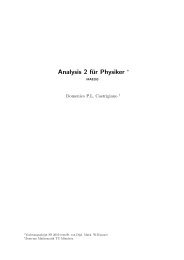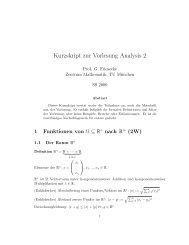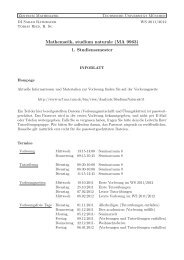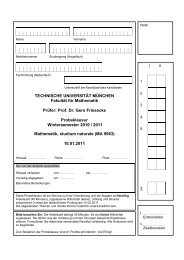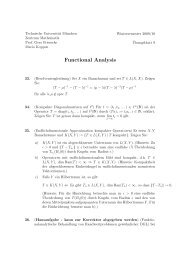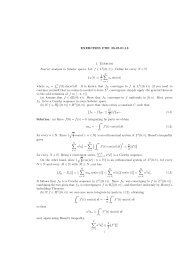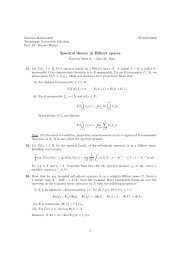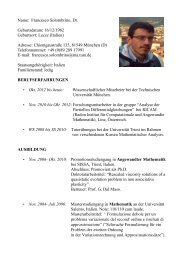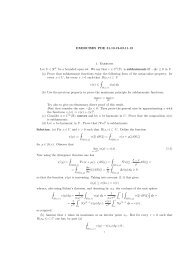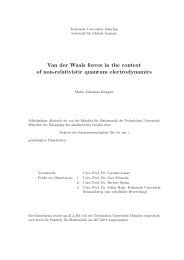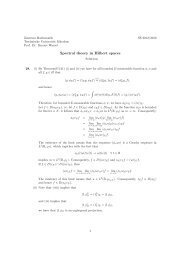Weak Convergence Methods for Nonlinear Partial Differential ...
Weak Convergence Methods for Nonlinear Partial Differential ...
Weak Convergence Methods for Nonlinear Partial Differential ...
Sie wollen auch ein ePaper? Erhöhen Sie die Reichweite Ihrer Titel.
YUMPU macht aus Druck-PDFs automatisch weboptimierte ePaper, die Google liebt.
Recall Schauder’s theorem from functional analysis: A linear operator T : X → Y<br />
between Banach spaces X and Y is compact if and only if the adjoint operator<br />
T ′ : Y ′ → X ′ is compact. Applying this to the compact embeddings W 1,p<br />
0 ֒→<br />
L p , 1 ≤ p < ∞, yields:<br />
Theorem 2.31 Suppose Ω ⊂ R n is open and bounded. The embeddings L q (Ω) ֒→<br />
W −1,q (Ω), 1 < q ≤ ∞ are compact.<br />
Proof. Let T : W 1,p<br />
0 → L p , Tu = u be the compact embedding operator. Then<br />
T ′ : (L p ) ′ → (W 1,p<br />
0 ) ′<br />
∫<br />
T ′ ϕ(u) = ϕ(Tu) = ϕu ∀ϕ ∈ (L p ) ′ , u ∈ W 1,p<br />
0 ,<br />
i.e. T ′ : L q → W −1,q is the natural embedding from L q into W −1,q and compact,<br />
too.<br />
□<br />
For p = 1 we have argued earlier that it is convenient to embed L 1 in the<br />
larger space M of Radon measures. We there<strong>for</strong>e prove a compact embedding<br />
result directly <strong>for</strong> M.<br />
Theorem 2.32 Suppose Ω ⊂ R n is open and bounded. The embeddings M(Ω) ֒→<br />
W −1,q (Ω), q < n , are compact.<br />
n−1<br />
Proof. For p > n, the embedding W 1,p<br />
0 ֒→ C 0 is compact. Similarly as be<strong>for</strong>e it<br />
follows that then also<br />
M ∼ = (C 0 ) ′ ֒→ (W 1,p<br />
0 ) ′ ∼ = W −1,q<br />
is compact <strong>for</strong> q = p<br />
n<br />
. It remains to note that p > n is equivalent to q < .<br />
p−1 n−1<br />
□<br />
2.5 A-quasiconvexity<br />
We now resume our disccussion of Section 2.2 on the (semi-)continuity properties<br />
of nonlinear functionals. Now, however, under additional differential constraints.<br />
More precisely, we will consider sequences (u (ν) ) ⊂ L ∞ (Ω; R m ) such that<br />
⎧<br />
⎪⎨<br />
(H)<br />
⎪⎩<br />
u (ν) ∗ ⇀ u L ∞<br />
( ) ∑<br />
Au (ν) =<br />
j,k a ∂u (ν)<br />
j<br />
ijk ∂x k<br />
i=1,...,q<br />
f(u (ν) ) ⇀ ∗ l L ∞ ,<br />
bd. in L 2 (Ω; R q ),<br />
where the a ijk ∈ R are constants and so A is a linear partial differential operator<br />
with constant coefficients.<br />
If (H) holds and additionally Au (ν) = 0 ∀ν we say that (H 0 ) holds.<br />
Examples:<br />
21



